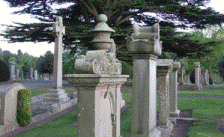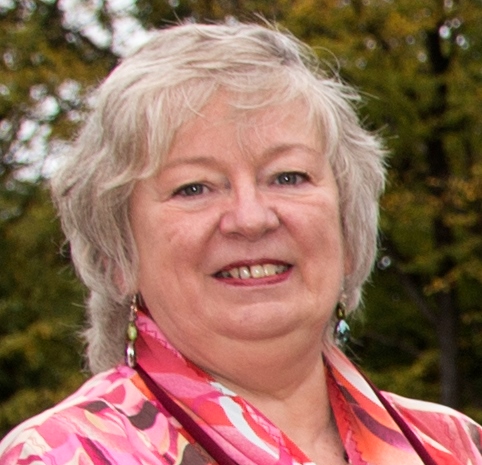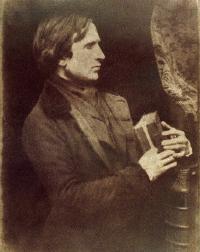- Birth*: Robert Adamson was born on 26 April 1821 at St Andrews & St Leonards, Fife, Scotland,
 .1
.1 - He was the son of Alexander Adamson and Rachel Melville.1
- (Deceased) Death*: Robert Adamson died on 14 January 1848 at St Andrews & St Leonards, Fife, Scotland,
 , at age 26 Adamson, Robert son of Alexander Adamson farmer Burnside died here 14th buried 18th January 1848.3
, at age 26 Adamson, Robert son of Alexander Adamson farmer Burnside died here 14th buried 18th January 1848.3 - (Witness) Wiki: He was mentioned in the wiki entry University of Glasgow:
David Octavius Hill & Robert Adamson
The partnership of David Octavius Hill and Robert Adamson (1821-1848) is one of the most significant and intriguing in the history of photography. The art of photography was announced to the public in 1839. Just four years later, in 1843, Robert Adamson established his studio in Rock House, on Calton Hill in Edinburgh. It was to be the site of some of the most sophisticated photography ever created - in early years on through to the present day.
Robert Adamson had enjoyed an intense upbringing in the fledgling art at St Andrews. His brother, Dr John Adamson, was a colleague and close friend of Sir David Brewster. Brewster had a unique relationship with the inventor of photography on paper, William Henry Fox Talbot. The two scientists shared information and experiences in photography with a freedom and openness unknown elsewhere in the beginning days of the art.
Robert Adamson, trained as an engineer and very clever indeed, was the full beneficiary of a legacy of innovative experimental information. This was critical at a time when all photographic materials were made by the photographer himself. The painter, David Octavius Hill, was highly popular and influential in the Edinburgh artistic community. His brother, Alexander Hill, was a premier publisher of prints. Between them, they had extensive contacts with society in Edinburgh and beyond.
The partnership was born in extraordinary circumstances. Almost simultaneously with Adamson opening his pioneering studio, the Church of Scotland was meeting in Edinburgh. In May, 1843, four hundred ministers - a third of the entire church - signed a Deed of Demission, resigning their livings and establishing the Free Church of Scotland. It was a true act of courage, rooted in deeply held convictions, for these men were not only surrendering their career, but also condemning their families to ostracism from the communities in which they lived.
This violent act of separation deeply impressed many, including D.O. Hill. He announced the undertaking of a great commemorative painting, to include all those present, which would be the basis of an engraving. As the many ministers would soon scatter throughout Scotland, it was Hill's friend Sir David Brewster who suggested a way to make the recording practical. Brewster introduced Hill to Adamson and overcame the artist's skepticism as to the value of photography. The two men soon entered into an enthusiastic partnership.
In their photography, Hill and Adamson produced calotype negatives. These were made on sheets of writing paper treated with light sensitive chemicals. Exposure times could run into several minutes in sunlight. The cameras were necessarily bulky as enlarging was not possible. The negative, which had to be the size of the final print, was printed by contact in full sunlight on a hand coated salt paper. Each negative and print had its own character. The prints were typically purple to reddish brown in tone, emphasizing broad masses of detail. They were frequently compared by contemporaries to the work of Rembrandt.
The initial idea of taking likenesses to be copied into the painting naturally led Hill & Adamson into portraiture. Their subjects rapidly extended beyond the ministers of the Free Church, and it is for portraiture that they are best known. However, they also did important architectural and city views, some landscapes, and photographs that were designed to document ways of life. The most famous of these is the extensive series done on the Newhaven fishermen and women.
This fruitful partnership was cut tragically short by the early death of Robert Adamson. Seriously ailing by 1847, he died at the beginning of 1848. Earlier scholarship by art historians often credited Hill as the sole author of the work - some later historians had disparagingly added "with Adamson" as a credit. Today it is recognized that the partnership was crucial to the production of their work. Robert Adamson's work was technically proficient but lacked flair and spontaneity before he met Hill. Equally, D.O. Hill's photographic efforts after the death of Adamson were dismal. It is clear that both men played a crucial role in the creation and the execution of the final images.
Incredibly, Hill & Adamson produced an estimated 3000 images in the less than four productive years of their partnership. Hill's painting of the Disruption - the original stimulus for their photography - was not completed until 1867. It is deservedly forgotten today, overshadowed by a body of photographic work from the earliest days of photography that in many ways has had no equal since.4 - (Witness) Wiki: He was mentioned in the wiki entry Robert Adamson (photographer) From Wikipedia, the free encyclopedia
Robert Adamson (26 April 1821 – 14 January 1848) was a Scottish chemist and pioneer photographer at Hill & Adamson. He is best known for his pioneering photographic work with David Octavius Hill and producing some 2500 calotypes, mostly portraits, within 5 years after being hired by Hill in 1843, before his life was cut short.
Contents 1 Early years 2 Career 3 Partial works 4 References 5 External links
Early Years
Adamson was born in St Andrews, one of ten children, and grew up in Burnside[disambiguation needed], the son of John Adamson, Sr., a Fifeshire farmer and his wife, Rachael Melville.[1] He received a basic education at Madras School in St Andrews where he showed exceptional talents in mathematics and mechanics, twice winning the prize for mathematics. He became employed at an engineering shop from a young age,[2] and apprenticed as a millwright for several months.[3]
Career
Adamson was keen on becoming an engineer, but spouts of ill health led to him pursuing photography.[4] He was taught calotype by his brother, John, and by the physicist David Brewster of the University of St Andrews in the late 1830s.[2] As early as April 1839, Adamson's talents were recognized, and Fox Talbot, the inventor of the calotype, would call his pictures "Rembrandtish".[5] Adamson's brother John, a general practitioner, lecturer, and curator of the University Museum, produced the first calotype in Scotland in 1841.[1]
'His Faither's Breeks', a Newhaven boy, by Robert Adamson and David Octavius Hill, 1843–1847; from the collection of the National Galleries of Scotland.
The young chemist,[6] Adamson, established his photographic studio at Rock House[disambiguation needed], Calton Hill Stairs in Edinburgh, on 10 May 1843.[7] In June, Brewster recommended Adamson to David Octavius Hill (1802–1870), a painter of romantic Scottish landscapes, who hired him;[5] and they were commissioned in 1843 to make a group portrait of the 470 clergymen who founded the Free Church of Scotland. Hill had desired to make photographic portraits of the founders purely as reference material.[8] This painting, however, would not be completed until 1866, long after his death.[9]
The first studio specialising in calotypes in Edinburgh,[1] Adamson's studio practice was said to have been "confidential to the point of secrecy".[10] Hill required calotypes from which he would paint. Distinguished persons from many fields came to be photographed by the partners and within a few years they had taken the art scene by storm in Scotland.[5] Together they made around 2500 portraits,[11][12] some say 3000 or more,[2] and numerous views of Edinburgh between 1843 and 1848, exhibiting in 1844, 1845 and 1846.[12] Their prints were sold at the Princes Street gallery of Alexander Hill. After Hill and Adamson decided to publish their work, they purchased a specialised camera in 1844, but their plans to produce albums, paid by subscription, did not gain traction.[3]
Their depictions, in soft reddish-brown or sepia,[13] included local and Fife landscapes and urban scenes, including images of the Scott Monument, under construction in Edinburgh. They produced several groundbreaking "action" photographs of soldiers and – perhaps their most famous photograph – two priests walking side by side. Their depictions of groups and children were unrivaled.[3] As well as the great and the good, they photographed ordinary working folk, particularly the fishermen of Newhaven and their wives. Their social documentary series on Newhaven fishing families, which depicted living conditions and community relationships, was to be the most notable work of the partnership.[14]
Graham Fyvie, Robert Cadell and Robert Cunningham Graham Spiers, by Robert Adamson.
By mid-1847, the studio stopped production due to the failing health of Adamson. Thinking to recuperate amidst his family, Adamson returned to St. Andrews. He died unmarried on 14 January 1848, at the age of 26.[3]
In 1851, the works of Hill & Adamson's appeared at The Great Exhibition.[3] Hill returned to painting, but it wasn't until 1872 that their work was rediscovered. In 1905, 1912, and 1914, some of their works appeared in Camera Work. There were also several New York City exhibits at Alfred Stieglitz's 291 Art Gallery and at the National Arts Club.[13]
Partial works
Miss Justine Munro
Miss Grizzel Baillie, Scotland
Mrs. Barbara (Johnstone) Flucker Opening Oysters
Bringing in the catch
Officer of the 92nd Gordon Highlanders Reading to the Troops, Edinburgh Castle
The Fairy Tree at Colinton
The Gowan
The Minnow Pool
The Rev. Dr. Jabez Bunting, Scotland
Dumbarton Presbytery
Willie Liston Redding the Line
References
1. Hill, David Octavius; Adamson, Robert; Ovenden, Graham (1973). Hill & Adamson photographs. Academy Editions. p. 6. Retrieved 17 July 2012.
2. "Photographic pioneer: partnership with Robert Adamson". Oxford Dictionary of National Biography (subscription required). Retrieved 17 July 2012.
3. Hannavy, John (24 August 2007). Encyclopedia of Nineteenth-Century Photography. CRC Press. pp. 658–. ISBN 978-0-415-97235-2. Retrieved 1 August 2012.
4. Kraus, Jr., Hans P. (1987*). Sun pictures. Hans P. Kraus, Jr., Inc. p. 30. Retrieved 17 July 2012. Check date values in: |date= (help)
5. Ford, Colin; Cameron, Julia Margaret (15 May 2003). Julia Margaret Cameron: A Critical Biography. Getty Publications. p. 85. ISBN 978-0-89236-707-8. Retrieved 17 July 2012.
6. Langford, Michael John (1997). The Story of Photography: From Its Beginnings to the Present Day. Taylor & Francis US. pp. 18–. ISBN 978-0-240-51483-3. Retrieved 1 August 2012.
7. Hill, David Octavius; Museum, J. Paul Getty; Adamson, Robert (25 March 1999). Hill and Adamson: Photographs from the J. Paul Getty Museum. Getty Publications. p. 143. ISBN 978-0-89236-540-1. Retrieved 17 July 2012.
8. Hill, David Octavius; Bell, Keith; Harris, David (1987). The photographs of David Octavius Hill and Robert Adamson. Mendel Art Gallery. p. 10. ISBN 978-0-919863-28-6. Retrieved 17 July 2012.
9. Newhall, Beaumont; Newhall, Nancy Wynne (1958). Masters of photography. G. Braziller. p. 14. ISBN 978-0-89104-010-1. Retrieved 17 July 2012.
10. Stevenson, Sara; Hill, David Octavius; Adamson, Robert (1991). Hill and Adamson's The fishermen and women of the Firth of Forth. Scottish National Portrait Gallery, Trustees of the National Galleries of Scotland. ISBN 978-0-903598-15-6. Retrieved 17 July 2012.
11. Hutchinson Encyclopedia (1988), p.10
12. Michaelson, Katherine (1970). A centenary exhibition of the work of David Octavius Hill, 1802–1870, and Robert Adamson, 1821–1848. Scottish Arts Council. p. 14. Retrieved 17 July 2012.
13. Jacobs, Philip Walker (9 March 2001). The Life and Photography of Doris Ulmann. University Press of Kentucky. pp. 27–. ISBN 978-0-8131-2175-8. Retrieved 1 August 2012.
14. Hannavy (2007), p. 659
External links Wikimedia Commons has media related to Hill & Adamson.
Works in the National Galleries of Scotland
Authority control
WorldCat VIAF: 100182255 LCCN: n50037548 ISNI: 0000 0001 0928 5573 GND: 118643649 BNF: cb12357868h (data) ULAN: 500010587 RKD: 127593
Categories: 1821 births 1848 deaths People from St Andrews Scottish photographers 19th-century photographers 19th-century Scottish people.5 - [S56] International Genealogical Index (IGI) (Salt Lake City, Utah, USA: International Genealogical Index), search result for Alexander Adamson family with Rachel Melville [Apr 2015].
- http://commons.wikimedia.org/wiki/File%3ARobert_Adamson_-_restore.jpg
- [S8] Old Parochial Register of Death, Dundee, pre-1855 (General Record Office of Scotland, 282/00 0270 0244 Dundee) OPR Deaths 1848 St Andrews & St Leonards ref 453/00 0210 0155 image held [Apr 2015].
- [S29] http://www.gla.ac.uk/services/specialcollections/collectionsa-z/hilladamson/hilladamsonbiographies/ [Apr 2015].
- [S29] http://en.wikipedia.org/wiki/Robert_Adamson_%28photographer%29 [Apr 2015].
Robert Adamson1
M, #11839, b. 26 April 1821, d. 14 January 1848
Last Edited: 25 Apr 2015
Parents:
Father*: Alexander Adamson1 b. c 1773, d. 1 Nov 1841
Mother*: Rachel Melville1 b. c 1781, d. 14 Oct 1871
Mother*: Rachel Melville1 b. c 1781, d. 14 Oct 1871
 Genes on the Web
Genes on the Web
